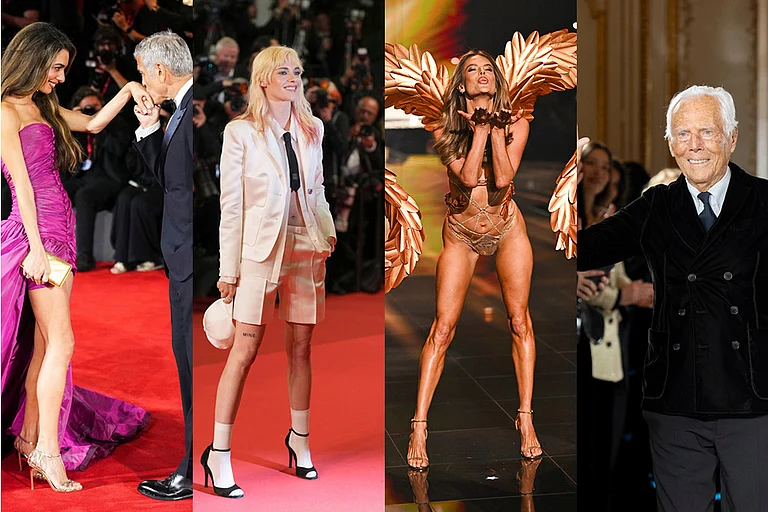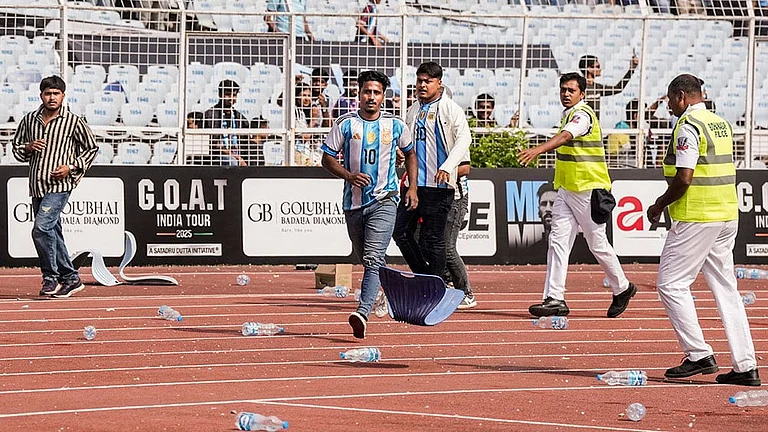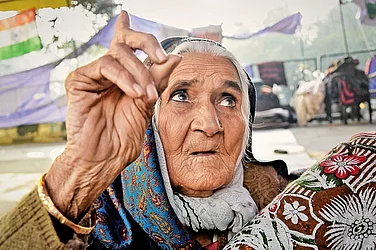Floating in an art gallery in Mumbai are 15 pieces of Jeogori, traditional Korean garments, made out of reconstructed sari of silk, cotton, paper, and polyester. There are no owners of these garments in sight, but only memories of the ones who adorned these pieces that remain suspended in the gallery. Each piece displayed by the artist is a witness and a testament.
Every garment used for the exhibition serves as a reminder of the entanglement of ‘cloth’ in structures of power, obedience, and resistance.
Showing what is often not seen, Datta’s exhibition ‘Volume IV’ unfolds across four conceptual ‘truth-states’—Truths Our Clothes Told Us, Half-Truths Our Clothes Told Us, Half-Lies Our Clothes Told Us, and Lies Our Clothes Told Us. The walls of the gallery are decorated with the truth and lie of life portrayed through clothes.
Datta, a former fashion designer, has long distanced himself from the trade after his disillusionment with the now hyper-nationalist fashion industry. A textile artist, Datta has re-emerged with his latest exhibition, wherein he showcases his love for textile and mapping the history of resistance, along with it his critique of the fashion industry as it exists in its current form. Not a comeback to fashion, but this exhibition of reclaimed and reconstructed textile is a quiet response to the culture of hyper-consumerism and fast fashion that has plagued the trade.

This exhibition displays reclaimed textiles as a rebellion against the politics of dress. Stitching together narratives of subjugation and liberation, Datta lays bare the role of clothing in enforcing power and how it continues to shape, contain, and communicate identity. “In particular, the abject class and caste systems that are still enforced in the regions of my interest,” influenced the way the exhibition came together.
Building on his previous solo exhibition that address the historical sumptuary laws, this exhibition also finds its root in his extensive research into these ancient and historical social and behavioural codes and their enduring impact and influence in contemporary times. His inspiration, ‘Ban Zhao’s Lessons for Women’, he says “felt extremely current. The text would not seem out of the ordinary at a political rally or in the pages of a newspaper today.” The book by Zhao, one of the earliest known female historians and scholars in Chinese history, is a prescriptive and reflective manual written for her daughters, but intended to guide all women in their moral and social conduct. While it was written centuries ago, the gendered prescriptions echo modern mandates.
Before it unfolds at the Experimenter showcasing four conceptual ‘truth-states’, Datta’s Volume IV begins with its raw material. Every piece of textile was donated and reclaimed, each piece an archive of lived experience. Since 2021, he has conducted clothing drives, collecting garments and with that, the weight of the memories carried by the ones who wore them.
“With the items of clothing, the donors also share memories, episodic events, and information about their donations. These are collected in the form of interviews, correspondence, conversations, and images from family albums. In most instances, the details gathered about the garments have a direct tie-in with the research I conduct,” he says.
“At the same time, there is a parallel activity of reclaiming textiles which are abandoned or discarded,” he adds. This eco-conscious approach by Datta is a radical act of resistance against fast fashion’s throwaway culture, a scathing critique on the industry he has long been a part of."
“Textiles age faster in South Asia,” Datta notes, citing “insect activity, climate, and more” as forces that degrade fabric. Yet, he insists, “The restorative and palliative care is essential,” especially for the clothing and textiles used for his projects. Working with ‘Ek Tara Creates’, a Kolkata social enterprise, he and women artisans restore these textiles through “intense quilting to intimate darning; the textiles get mapped out in a grid formation facilitating the complex build plans of each work”.
Here, slowness is not a delay, but a deliberate methodology—a refusal to participate in fashion’s accelerating churn. Through these pieces, Datta cultivates a counter-rhythm, privileging process over product, memory over novelty. His exhibition is a sharp critique of the constant devaluation of nature and labour and his environmentally and socially conscious approach subverts the cycle of waste. It is a call to the people to reflect, meditate and respond to this system of policing of fashion, bodies and communities in the face of consumerism by rejecting it and reclaiming the past, memory and the defiance it embodies.
Datta’s exhibition is an inquiry into global dress codes across the world, which began as a research into shrouding and swaddling practices across Southwest Asia, North Africa (SWANA), the Korean Peninsula and Japan.
“The act of veiling is seen as an Islamic preoccupation, but veiling predates Islam. It has existed across regions, cultures and timelines,” he noted while pointing to sumptuary laws and religious edicts that have for long policed caste, gender, and sexuality.
His 13-year research into global dress codes revealed to him how garments enforce control. To him, it was apparent that the constriction felt in the ‘cloth’, extended onto the home, the private, the public.

“Clothing, since its inception, has been used by dominant forces to intimidate, control, and subjugate people,” he says. His research was then materialised in the exhibition in the form of architectural drawings, cartographic exercises, and posters; all in textile. Volume IV is a call to unpick the lies our clothes tell, to find the truths beneath, and to stitch new stories together.
Each chapter of Volume IV exhibition functions as both an archive and an inquiry, inviting viewers to examine how garments have historically functioned as both tools of expression and instruments of regulation. “Clothing edicts have never existed in a vacuum. The politics of the body have always been aligned with the constrictions of public and private lives experienced by gender and sexual minorities. Even today, we see how an item of clothing and the codes around it impacts access to education, personal safety, and approaches to employment. Basic human rights one would think,” Datta explains.
His collaboration with ‘Ek Tara Creates’ is a step towards amplifying marginalised voices, making care revolutionary. “As with my artistic and curatorial projects, Volume IV foregrounds care as a connective principle—during all the processes including the installation,” Datta says. He invites his audience and through his work has a dialogue with them. He wants them to feel secure and take their time engaging with the works. Datta wants viewers to “have conversations even after the run of the solo”.
In Volume IV, a frayed sari becomes a cartographic exercise; a darned shirt, a testament to survival. The truth-state “Lies Our Clothes Told Us” exposes how garments obscure identities and struggles. Think of a veil mandated to erase a woman’s agency or a colour banned to mark caste inferiority, the artist’s critique of clothing as a tool of control is unflinching, exposing how power operates through the mundane. The artist questions the system and its unrelenting control over bodies that have been historically marginalised.
By amplifying these textiles’ stories, Datta defies the hierarchies that dictate visibility. In a fashion landscape obsessed with newness, his reclamation of textiles is a beacon of rebellion. Datta’s reclaimed textiles reject disposability and couture’s elitism, offering a vision of clothing as history, resistance, and care.
(with inputs from Jinit Parmar)


























